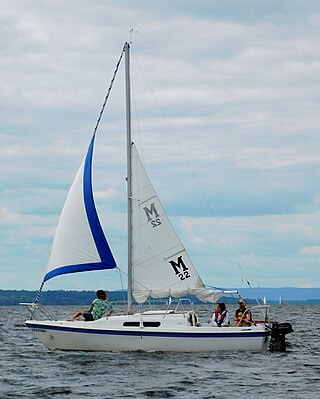Related Research Articles
The Hunter 240 is an American trailerable sailboat that was designed by the Hunter Design Team and first built in 1998.
The Parker Dawson 26 is an American trailerable sailboat that was designed by Robert Finch as a cruiser and first built in 1972.
The Amphibi-Con 25, often just called the Amphibi-Con, is an American trailerable sailboat that was designed by E. Farnham Butler and Cyrus Hamlin as a racer-cruiser and first built in 1954. The design was one of the first "trailer sailers" and helped popularize this class of boat.
The Weekender 24 is an American trailerable sailboat that was designed by Sparkman & Stephens as a cruiser and first built in 1965. It was Sparkman & Stephens design number 1701-C1.
The Antrim 20 is an American trailerable sailboat that was designed by Jim Antrim as a cruiser and first built in 1982.
The Bremer 25 is an American trailerable sailboat that was designed by Mark Bremer as a racer-cruiser and first built in 1995.
The Dehler 25 is a German trailerable sailboat that was designed by E. G. van de Stadt as a cruiser and first built in 1984.
The ETAP 20 is a Belgian trailerable sailboat that was designed by E. G. van de Stadt as a cruiser and first built in 1975.
The Freedom 24 is an American trailerable sailboat that was designed by William H. Tripp, III as a racer-cruiser and first built in 1994.

The MacGregor 22 is an American trailerable sailboat that was designed by Roger MacGregor as a cruiser and first built in 1967.
The Menger Cat 17 is an American trailerable sailboat that was designed by Andrew Menger as a daysailer and cruiser and first built in 1983.
The Menger Cat 19, also sold as the Thom Cat 19 Catboat, is an American trailerable sailboat that was designed by father and son team Bill Menger and Andrew Menger as a daysailer and cruiser and first built in 1990.
The Mystic Catboat 20 is an American trailerable sailboat that was designed by Peter Legnos as a cruiser and first built in 1974.
The Pearson 23 is an American trailerable sailboat that was designed by William Shaw as a cruiser and first built in 1978.
The Mustang 22 is an American trailerable sailboat that was designed by Martin Bludworth as a Midget Ocean Racing Club racer and first built in 1969.
The S2 6.7 Grand Slam is an American trailerable sailboat that was designed by Don Wennersten as a racer-cruiser and first built in 1980. The designation indicates the approximate length overall in meters.
The S2 6.9, also marketed as the S2 6.9 Grand Slam, is an American trailerable sailboat that was designed by Don Wennersten and Graham & Schlageter as racer-cruiser and first built in 1983. The designation indicates the approximate length overall in meters.
The Seaward 24 is an American trailerable sailboat that was designed by Nick Hake as a cruiser and first built in 1984.
The Vivacity 20 is a British trailerable sailboat that was designed by Peter Stevenson and Des C. Pollard as a racer-cruiser and first built in 1963.
The Nomad 22 is a British trailerable sailboat that was designed by Denys Rayner as a cruiser and first built in 1967.
References
- 1 2 3 4 5 6 7 8 McArthur, Bruce (2020). "Oysterman 23 sailboat". sailboatdata.com. Archived from the original on 4 August 2021. Retrieved 4 August 2021.
- 1 2 3 4 5 6 7 8 9 Henkel, Steve: The Sailor's Book of Small Cruising Sailboats, page 237. International Marine/McGraw-Hill, 2010. ISBN 978-0-07-163652-0
- ↑ McArthur, Bruce (2021). "Menger Boatworks (USA) 1976 - 2004". sailboatdata.com. Archived from the original on 29 July 2021. Retrieved 4 August 2021.